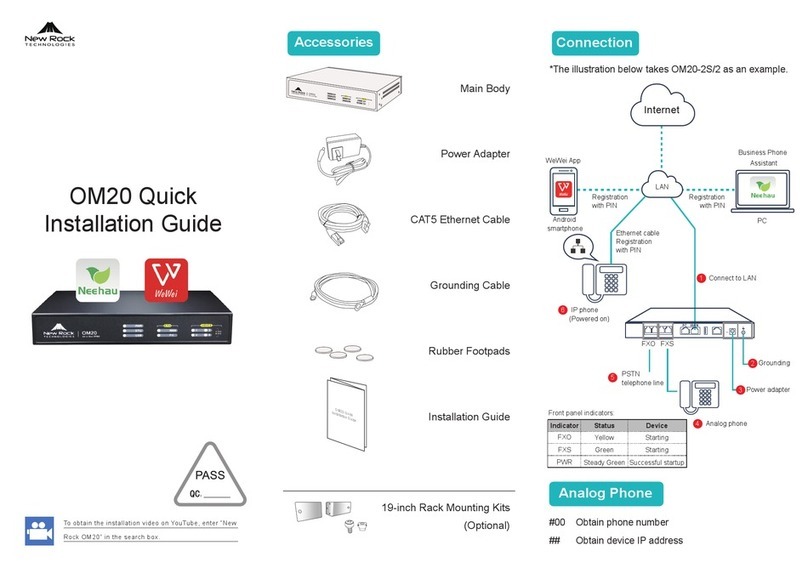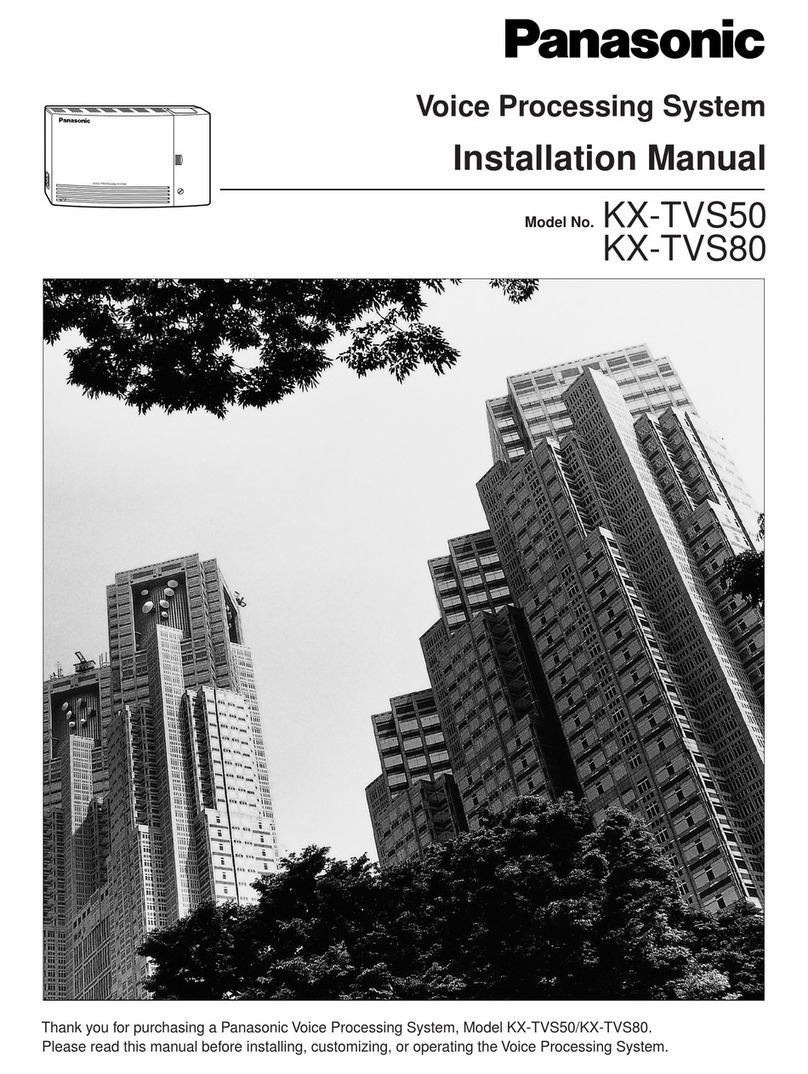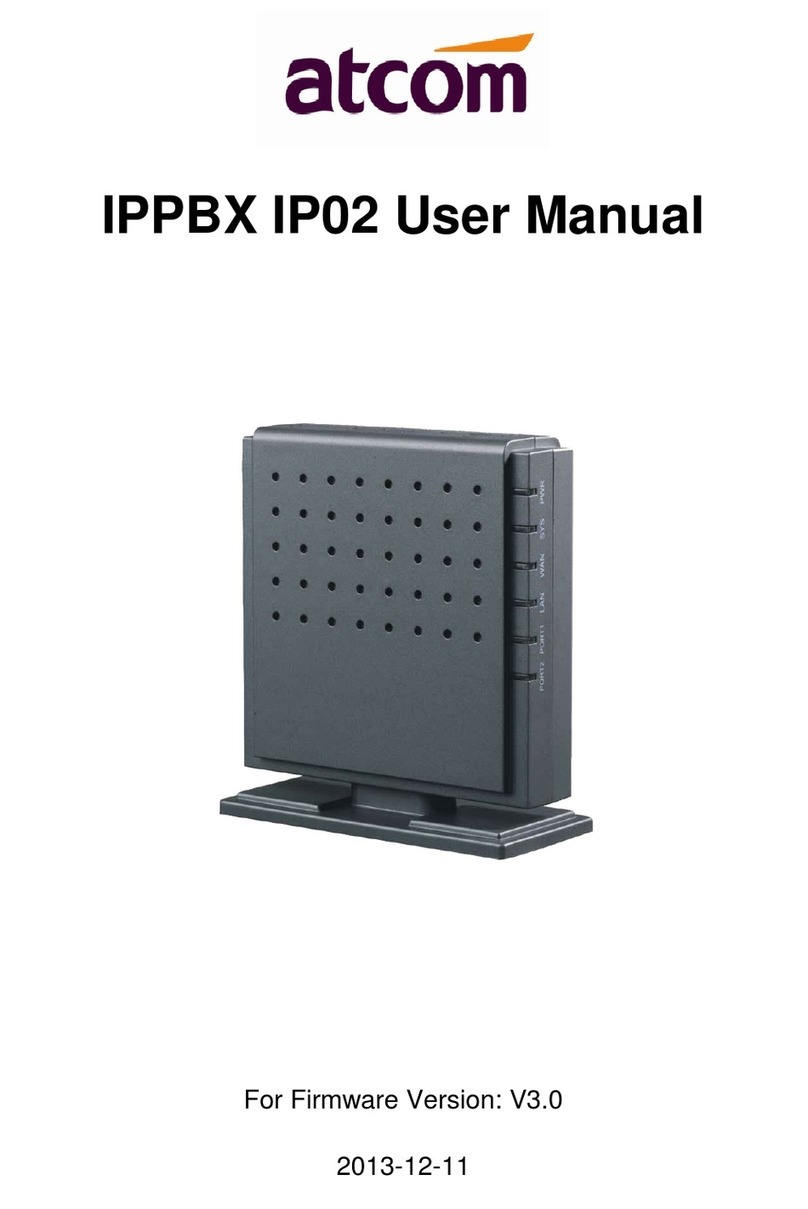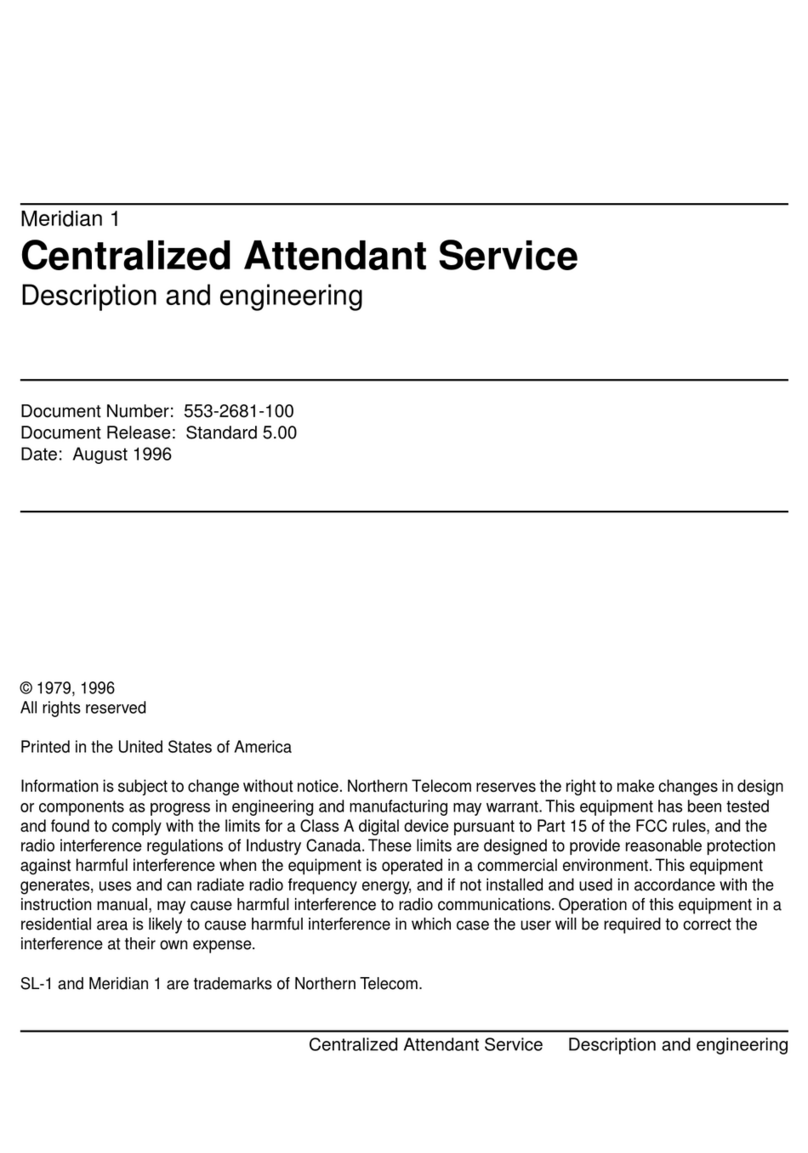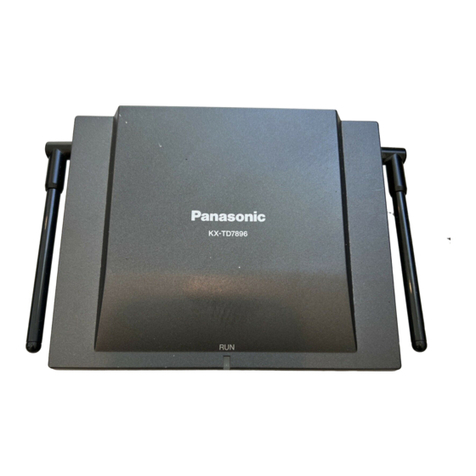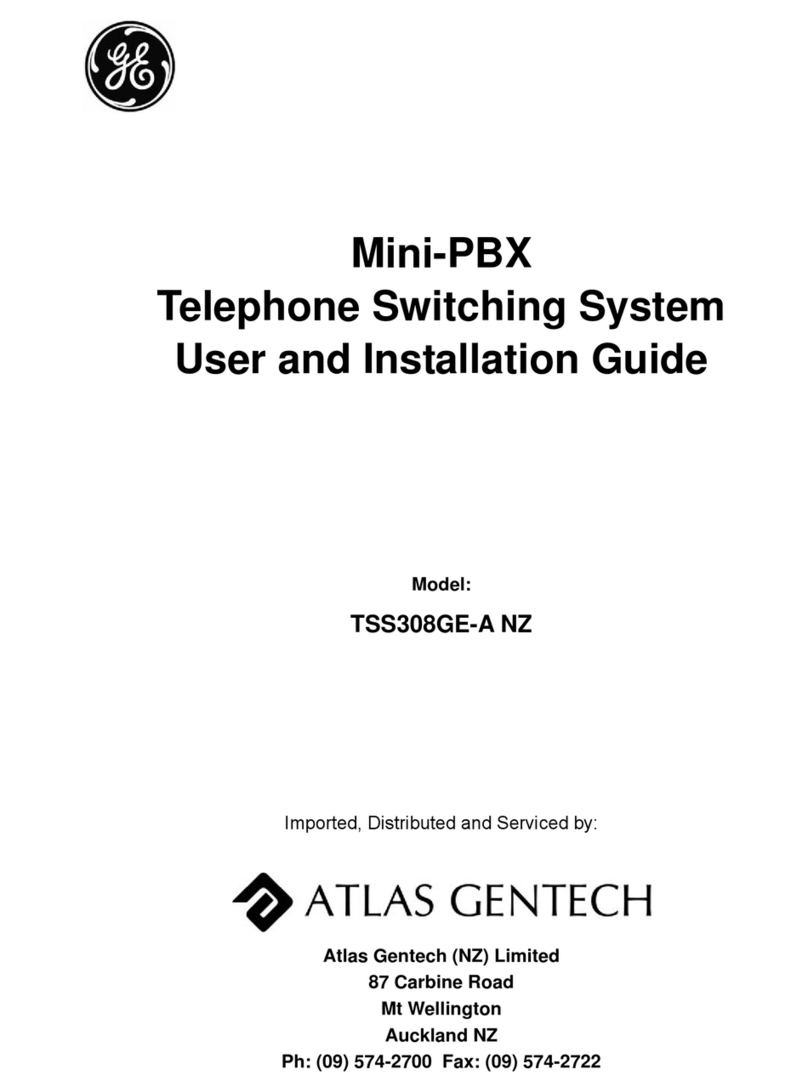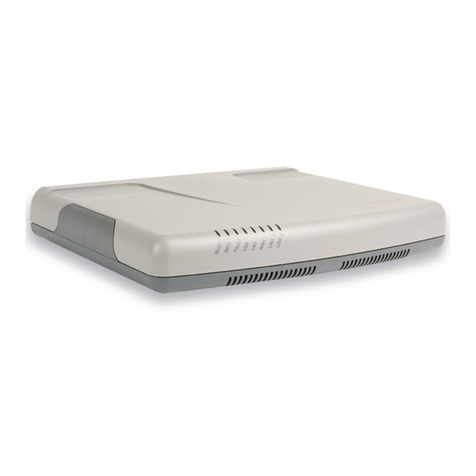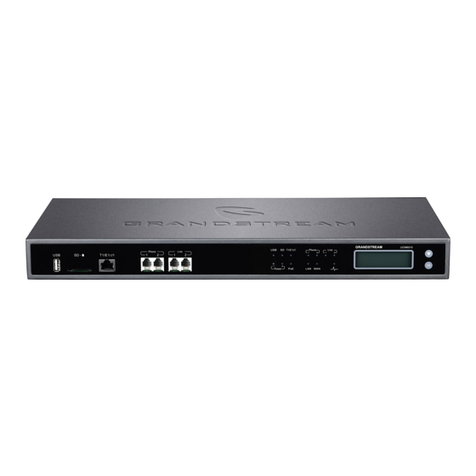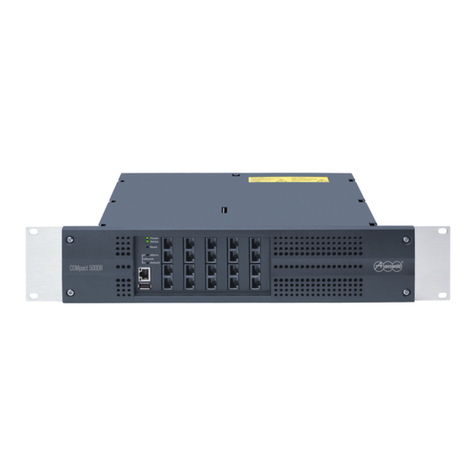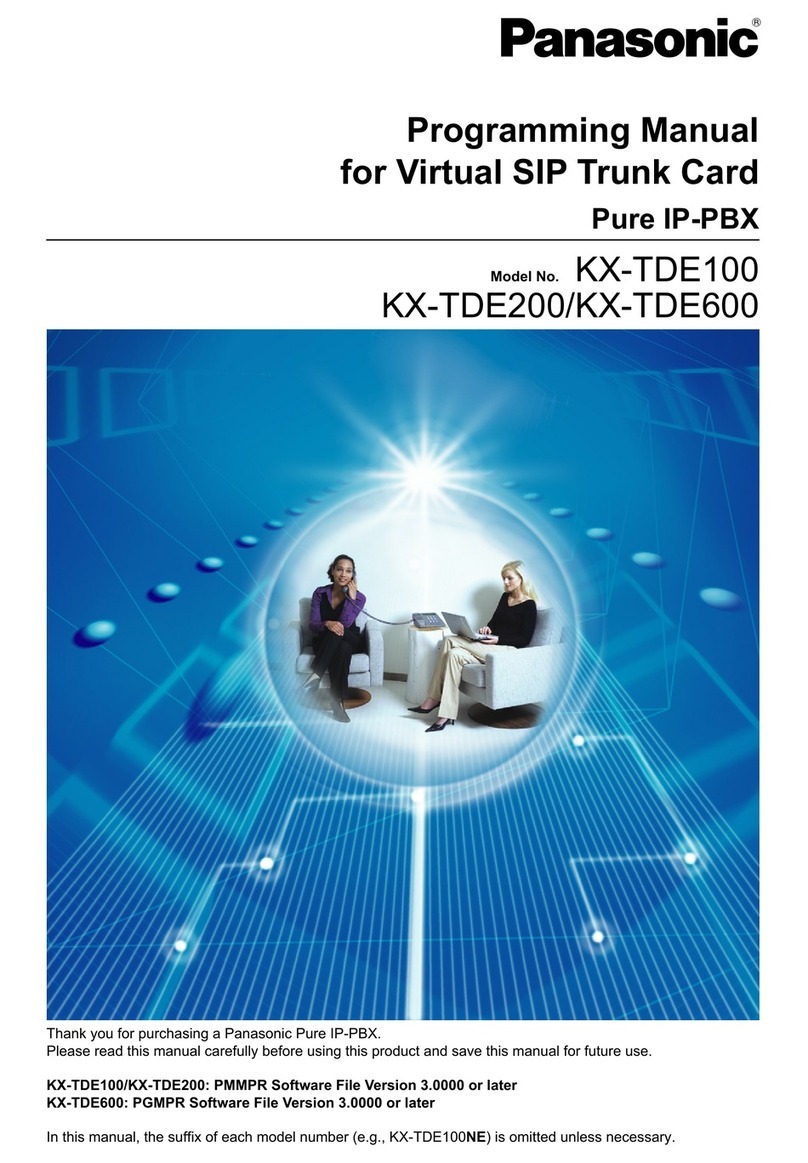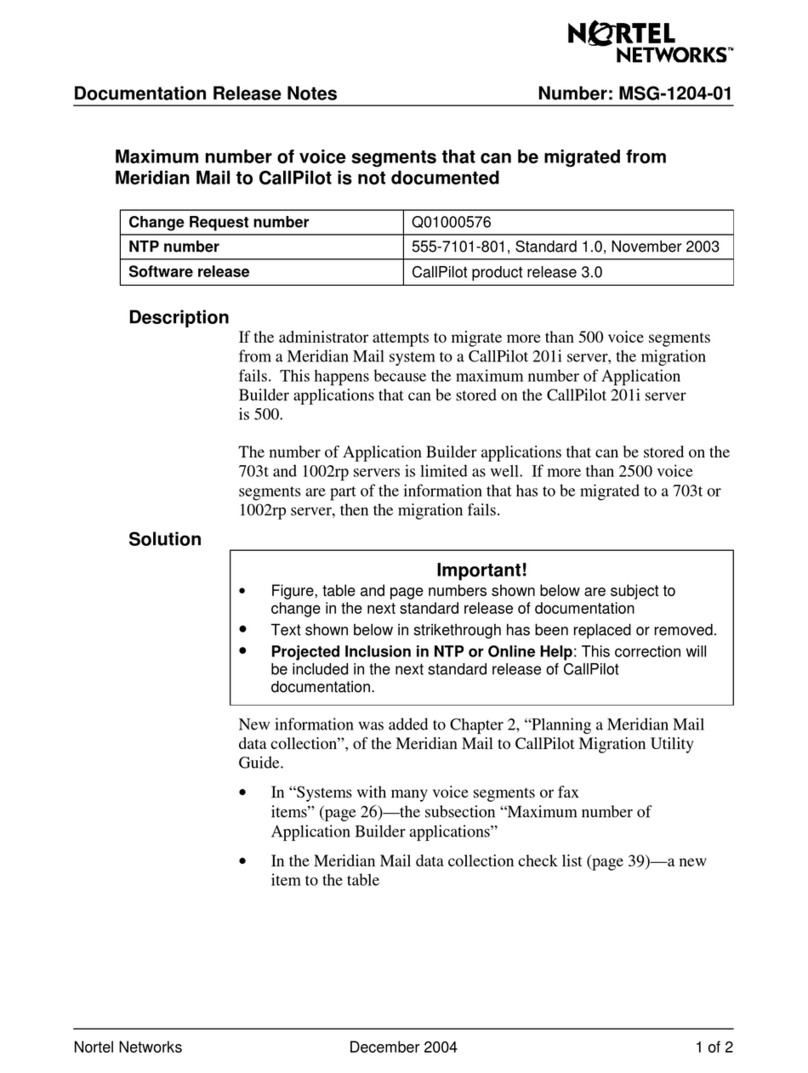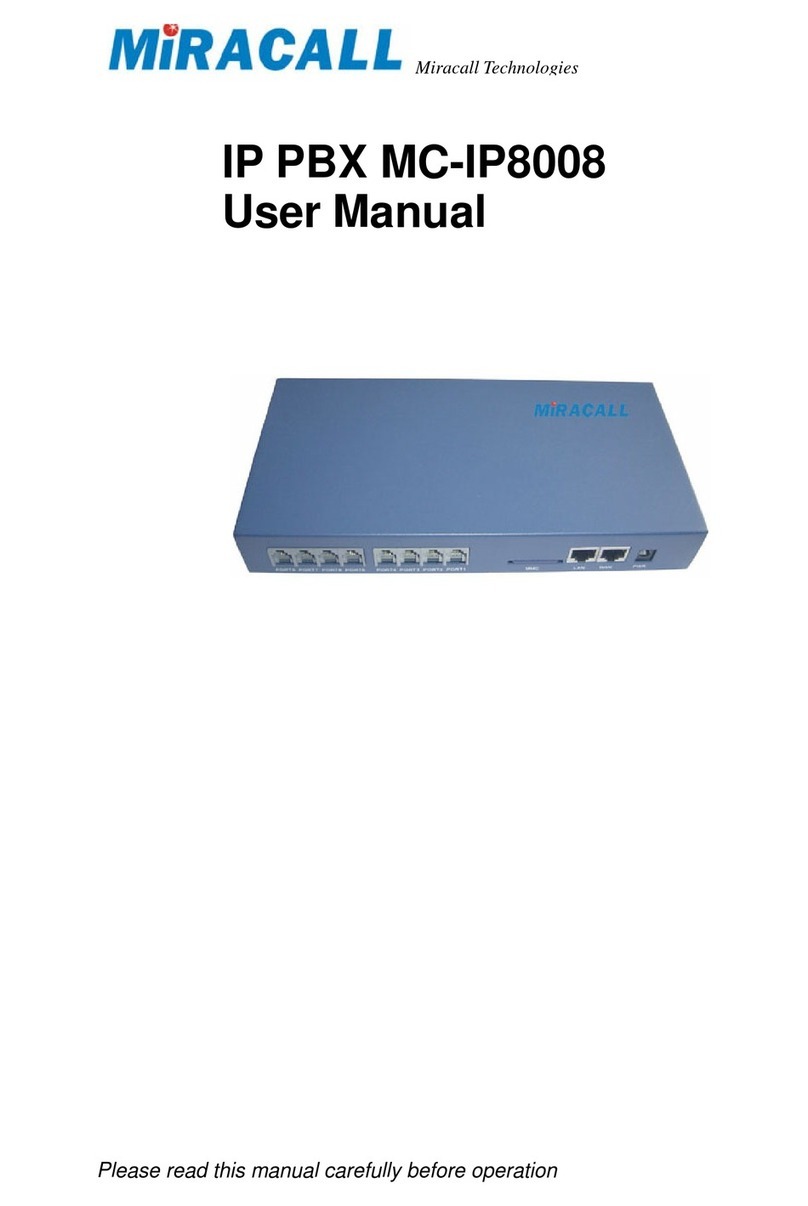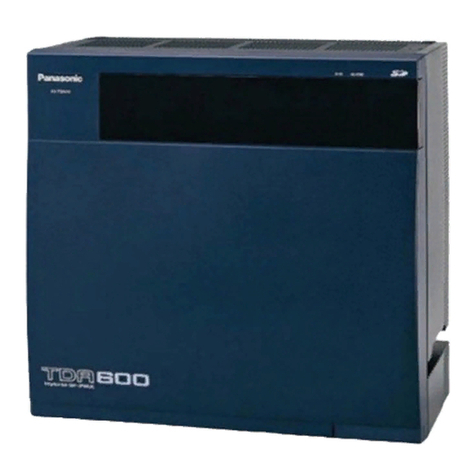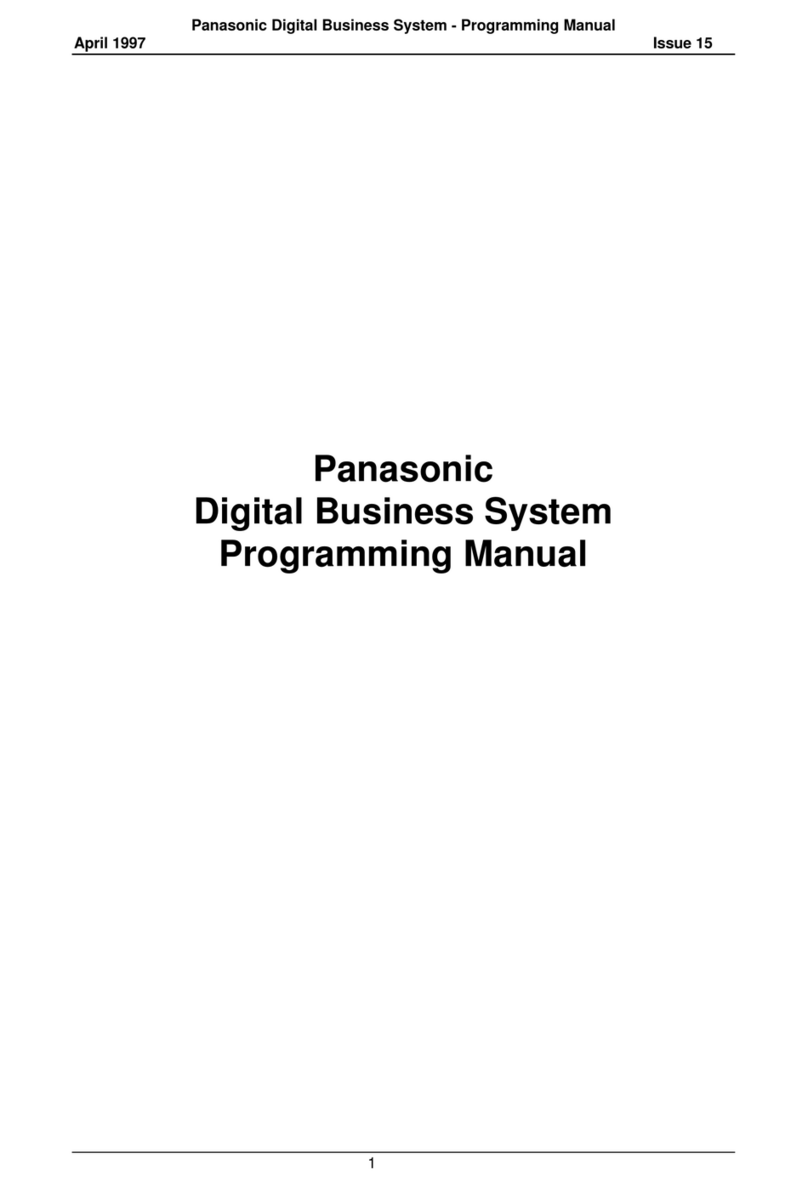New Rock Technologies OM10 User manual

IP-PBX Series
OM10
OM20
OM200
User Manual
New Rock Technologies, Inc.
Building 11, 777 Long Wu Road
Shanghai, 200232
China
www.newrocktech.com
Tel: 0086-21-61202700
E-mail: sales@newrocktech.com

Shanghai New Rock Technologies Inc. Page2/75
Amendent Records
Document Rev. 2.0 (Jan. 07, 2010)
Content updates of the document are as follows:
1) Several features are added, including dumping the TDM signal and IP packets from
Web-based utility
2) Changes are made for the configuration of analog extension, IP extension, IP trunks,
and attendant, and dialing plan and feature codes
Document Rev. 1.1 (Oct. 27, 2009)
Content updates of the document are as follows:
3) Adjustment of content was made based on the new Web user interface.
4) OM20 and OM200 were added.
5) Instructions for use of recording, tie trunk and other new functions were added.
Copyright © 2010 New Rock Technologies, Inc. All rights reserved
All or part of this document may not be excerpted, reproduced and transmitted in
any form or by any means without prior written permission from the company.

Shanghai New Rock Technologies Inc. Page3/75
Contents of Table
1 Overview ........................................................................................................................................9
1.1 Introduction...........................................................................................................................................9
1.2 Functions and Features..........................................................................................................................9
1.3 Equipment Structure............................................................................................................................10
1.3.1 OM10......................................................................................................................................10
1.3.2 OM20......................................................................................................................................12
1.3.3 OM100....................................................................................................................................14
1.3.4 OM200....................................................................................................................................16
2 Parameter Setting........................................................................................................................21
2.1 Login to Web-based Utility.................................................................................................................21
2.1.1 Obtain OM IP Address............................................................................................................21
2.1.2 Logon......................................................................................................................................22
2.2 Buttons Used on OM Web-based Utility.............................................................................................23
2.3 Basic Configuration.............................................................................................................................23
2.3.1 Status.......................................................................................................................................23
2.3.2 Network Configuration ...........................................................................................................23
2.3.3 Dialing Rules...........................................................................................................................26
2.3.4 Auto Attendant........................................................................................................................28
2.4 Extension.............................................................................................................................................29
2.4.1 Analog Ext. .............................................................................................................................29
2.4.2 IP Ext. .....................................................................................................................................33
2.4.3 Department..............................................................................................................................34
2.4.4 Department..............................................................................................................................36
2.5 Trunking..............................................................................................................................................37
2.5.1 Analog Trunk..........................................................................................................................37
2.5.2 IP Trunk..................................................................................................................................38
2.5.3 IP Trunk Registration..............................................................................................................39
2.6 System.................................................................................................................................................40
2.6.1 Characteristics of trunk line ....................................................................................................40
2.6.2 Characteristics of line..............................................................................................................41
2.6.3 Greeting...................................................................................................................................43
2.6.4 Recording................................................................................................................................44
2.6.5 Call Record .............................................................................................................................45
2.6.6 Functional keys.......................................................................................................................46
2.6.7 Tones.......................................................................................................................................48
2.7 Advanced Configuration .....................................................................................................................49
2.7.1 System.....................................................................................................................................49

Shanghai New Rock Technologies Inc. Page4/75
2.7.2 Media ......................................................................................................................................51
2.7.3 SIP related configuration.........................................................................................................54
2.7.4 Routing Table..........................................................................................................................55
2.7.5 Application Examples of Routing Table.................................................................................59
2.7.6 Digit Map................................................................................................................................60
2.7.7 Tie trunk..................................................................................................................................61
2.7.8 Encrypt....................................................................................................................................64
2.8 Log management.................................................................................................................................65
2.8.1 Resource status........................................................................................................................65
2.8.2 Call message ...........................................................................................................................67
2.8.3 System Startup ........................................................................................................................67
2.8.4 Configure log ..........................................................................................................................67
2.9 System tool..........................................................................................................................................68
2.9.1 Change password ....................................................................................................................68
2.9.2 Software upgrade ....................................................................................................................69
2.9.3 Configuration import...............................................................................................................70
2.9.4 Configuration export...............................................................................................................71
2.9.5 Software restart .......................................................................................................................71
2.9.6 System reboot..........................................................................................................................71
2.9.7 Restore factory settings...........................................................................................................72
2.9.8 TDM Capture..........................................................................................................................72
2.9.9 Ethereal capture.......................................................................................................................72
2.10 Product information...........................................................................................................................72
2.11 Logout...............................................................................................................................................73
3 Appendix......................................................................................................................................74
3.1 OM200 system operation state............................................................................................................74
3.2 Setting of Recording Storage Server ...................................................................................................74

Shanghai New Rock Technologies Inc. Page5/75
Contents of Figure
Figure 1-1 OM10 Front Panel ...................................................................................................................11
Figure 1-2 OM10 Back Panel....................................................................................................................11
Figure 1-3 OM20 Front Panel ...................................................................................................................12
Figure 1-4 OM20 back panel.....................................................................................................................14
Figure 1-5 OM100 Front Panel .................................................................................................................15
Figure 1-6 OM100 Back Panel..................................................................................................................15
Figure 1-7 OM200 Front Panel .................................................................................................................17
Figure 1-8 OM200 Back Panel..................................................................................................................18
Figure 1-9 Schematic Diagram for Front Panel of OM200 Dual-Chassis System.....................................19
Figure 1-10 Schematic Diagram for Back Panel of OM200 Dual-Chassis System...................................20
Figure 2-1 Login Interface of OM Web-based Utility...............................................................................22
Figure 2-2 Status Interface........................................................................................................................23
Figure 2-3 Network Configuration Interface.............................................................................................24
Figure 2-4 Dialing rule configuration interface.........................................................................................27
Figure 2-5 Configuration interface of Auto Attendant ..............................................................................28
Figure 2-6 Basic configuration interface of analog extension...................................................................29
Figure 2-7 Others configuration interface of analog extension .................................................................31
Figure 2-8 Basic configuration interface of IP extension..........................................................................33
Figure 2-9 Others configuration interface of IP extension ........................................................................34
Figure 2-10 Registration configuration interface of IP extension..............................................................35
Figure 2-11 Department configuration interface.......................................................................................37
Figure 2-12 Configuration interface of analog trunk.................................................................................37
Figure 2-13 General configuration interface of IP trunk ...........................................................................38
Figure 2-14 Registration configuration interface of IP trunk.....................................................................39
Figure 2-15 Trunk line characteristics configuraiton interface..................................................................40
Figure 2-16 Line characteristics configuration interface...........................................................................41
Figure 2-17 Configuration interface of greeting........................................................................................43
Figure 2-18 Configuration interface of recording......................................................................................44
Figure 2-19 Framework of Recording.......................................................................................................45
Figure 2-20 Configuration interface of call record....................................................................................45
Figure 2-21 Functional keys configuration interface.................................................................................46
Figure 2-22 Configuration interface of tones ............................................................................................49
Figure 2-23 Inferface of system advanced configuraiton ..........................................................................50
Figure 2-24 Configuration interface of media...........................................................................................52
Figure 2-25 SIP related configuration interface ........................................................................................54
Figure 2-26 Configuration Interface for Routing Table.............................................................................55
Figure 2-27 Illustrative interface for routing configuration.......................................................................56
Figure 2-28 Configuration Interface for Digit Map...................................................................................60
Figure 2-29 Configuration interface of tie trunk .......................................................................................62

Shanghai New Rock Technologies Inc. Page6/75
Figure 2-30 Reference Tie Trunk Diagram...............................................................................................62
Figure 2-31 Tie Trunk Application Diagram in OM.................................................................................64
Figure 2-32 Encrypt configuration interface .............................................................................................64
Figure 2-33 System Status Interface..........................................................................................................66
Figure 2-34 Call message interface...........................................................................................................67
Figure 2-35 Interface of system startup.....................................................................................................67
Figure 2-36 Interface of debugging log management................................................................................68
Figure 2-37 Interface of password changing .............................................................................................69
Figure 2-38 Interface of software upgrade ................................................................................................69
Figure 2-39 Interface of file upload...........................................................................................................69
Figure 2-40 Upgrade interface...................................................................................................................70
Figure 2-41 Prompt of upgrade process ....................................................................................................70
Figure 2-42 Interface of successful upgrade..............................................................................................70
Figure 2-43 Interface of import data..........................................................................................................71
Figure 2-44 Interface of export data..........................................................................................................71
Figure 2-45 Configuration interface of product information.....................................................................72

Shanghai New Rock Technologies Inc. Page7/75
Contents of Table
Table 1-1 Differences Between OM Series.................................................................................................9
Table 1-2 OM10 Configurations...............................................................................................................10
Table 1-3 Description of OM10 Front Panel.............................................................................................11
Table 1-4 Description of OM10 back panel ..............................................................................................11
Table 1-5 Configuration Description of Analog Extension Interfaces for OM10......................................11
Table 1-6 OM20 Configuration.................................................................................................................12
Table 1-7 Description of OM20 Front Panel.............................................................................................12
Table 1-8 Pins and Indicators for FXS and FXO of OM20.......................................................................13
Table 1-9 for Pin and Indicator Table of Ethernet Ports............................................................................13
Table 1-10 Indicators of OM20.................................................................................................................13
Table 1-11 Description of OM20 Back Panel ...........................................................................................14
Table 1-12 Properties of OM20 CON Port................................................................................................14
Table 1-13 OM100 Configuration.............................................................................................................14
Table 1-14 Description of OM100 Front Panel.........................................................................................15
Table 1-15 Indicators of OM100...............................................................................................................15
Table 1-16 Description of OM100 Back Panel .........................................................................................16
Table 1-17 OM200 Configuration.............................................................................................................16
Table 1-18 Description of OM200 Front Panel.........................................................................................17
Table 1-19 Pin Specifications for OM200 RJ45 Socket Port ....................................................................17
Table 1-20 Corresponding Relation Between OM200 RJ45 Socket and Line Number.............................17
Table 1-21 OM200 Back Panel.................................................................................................................18
Table 1-22 Meanings of OM200 Indicators ..............................................................................................19
Table 2-1 Default IP Address of OM ........................................................................................................21
Table 2-2 Default Passwords of OM.........................................................................................................22
Table 2-3 Configuration parameter of Network........................................................................................24
Table 2-4 Configuration parameters of dialing plan..................................................................................27
Table 2-5 Configuration Parameters of Auto Attendant............................................................................28
Table 2-6 Basic configuration parameter of analog extension...................................................................29
Table 2-7 Others configuration parameter of analog extension.................................................................31
Table 2-8 Basic configuration parameter of IP extension..........................................................................33
Table 2-9 Others parameter of IP extension..............................................................................................34
Table 2-10 Registration configuration parameter of IP extension.............................................................35
Table 2-11 Configuration parameter of analog trunk ................................................................................37
Table 2-12 General configuration parameter of IP trunk...........................................................................38
Table 2-13 Registration configuration parameter of IP trunk....................................................................39
Table 2-14 Configuration parameter of trunk line characteristics .............................................................40
Table 2-15 Line characteristics configuration parameter ..........................................................................41
Table 2-16 Voice File Table Used on the OM...........................................................................................43
Table 2-17 Configuration parameter of recording.....................................................................................44

Shanghai New Rock Technologies Inc. Page8/75
Table 2-18 Configuration parameter of call record ...................................................................................46
Table 2-19 The use of feature codes..........................................................................................................46
Table 2-20 Configuration parameter of tones............................................................................................49
Table 2-21 Parameters of system advanced configuration ........................................................................50
Table 2-22 Configuration parameter of media ..........................................................................................52
Table 2-23 Codec Methods Supported by OM..........................................................................................53
Table 2-24 Mapping between the reliability requirement and the TOS value...........................................53
Table 2-25 Configuration parameter of SIP related...................................................................................54
Table 2-26 Routing Table Format.............................................................................................................57
Table 2-27 Number Transformations........................................................................................................57
Table 2-28 Routing Destination ................................................................................................................59
Table 2-29 Description of Digit map.........................................................................................................61
Table 2-30 Configuration parameter of tie trunk.......................................................................................62
Table 2-31 Intelligent Routing Table ........................................................................................................63
Table 2-32 Trunk Routing Table of OM Reference Configuration...........................................................63
Table 2-33 Encrypt configuration parameters...........................................................................................64
Table 2-34 Parameters of system status.....................................................................................................66
Table 2-35 Configuration parameters of debugging log management.......................................................68
Table 3-1 OM200 system operation state..................................................................................................74
Table 3-2 Hardware Requirements for Recording Storage Sever..............................................................74
Table 3-3 Specification of OM Recording ................................................................................................74

Shanghai New Rock Technologies Inc. Page9/75
1 Overview
1.1 Introduction
Officium (hereinafter called “OM”) is a “All-in-One” business telephone system designed for small
and mid-size enterprises. It is integrated with Internet telephony, legacy PBX features, instant
messaging, user status display, and local and remote management mechanism to provide an efficient
and easy-to-use unified communication platform for office staff. Featuring built-in interfaces to
analog phones, PSTN lines, SIP-based trunks and SIP registration service, OM connects directly to
analog phones, facsimile machines, lines from local Central Office, as well as to components in IP
telephony network such as soft switches, IP-PBXs and SIP telephone and soft phone. OM offers
functions such as auto-attendant, monitoring of extension status, mobile extension, callback,
corporate CRBT, click-to-dial, call transfer, call waiting, voice mail, call recording and etc.
OM is a cost-effect solution for carriers to deploy business telephone service to enterprises, and it is
also used for small and mid-size enterprises to build private telephone system serving multi-location
branch offices and home working.
OM Series include OM10,OM20,OM100 and OM200 subseries. Their features are similar with the
main differences as follows:
Table 1-1 Differences Between OM Series
Capacity Chassis Line Card Install
ation Power
OM10 Able to configure
4-8 user ports and
register 30 IP
extensions
Plastic casing Built-in Deskt
op 5-9 VDC
OM20 Able to configure
16-24 user ports
and register 60 IP
extensions
19–inch wide
and 1U high
chassis
Built-in Rack 100-240 VAC
OM100 Able to configure
24-48 user ports
and register 120 IP
extensions
19–inch wide
and 1U high
chassis
Pluggable Rack 100-240 VAC,
-48 VDC
(Optional)
OM200 Able to configure
32-96 user ports
and register 120 IP
extensions
19–inch wide
and 1U high
main chassis and
extension
chassise as
option
Pluggable Rack 100-240 VAC,
-48 VDC
(Optional)
1.2 Functions and Features
zBuilt-in SIP register and proxy server
zLocal analog extensions and remote SIP extensions
zMobile extensions
zAuto-attendant

Shanghai New Rock Technologies Inc. Page10/75
zOperator
zDirect inward dialing (DID)
zAutomatic call distribution
zExtension features such as call forwarding, call waiting, call hold, call pickup, call transfer,
five-level call restriction, CRBT, and etc.
zVoice mail and call recording
zMornitoring of extension and trunk status
zEncryptions
zCall logs
zCall detailed record
zWeb-based utility for local and remote management
zSIP-based Tie trunks
zRouting table up to 100 rules
zGain adjustment of extensions and analog trunks
zSTUN and NAT traversal
zSupport terminals including telephone, facsimile machine and PBX
zT.30/T.38 fax
zSecond stage dialing or voice prompt over FXO ports
zPSTN failover through FXO ports
zXML/HTTP-based API for 3rd party application software
1.3 Equipment Structure
1.3.1 OM10
OM10 is the product with smallest capacity in OM IPPBX Series. Designed with small plastic
structure for desktop placement, OM10 can provide up to 8 analog line interfaces. OM10 supports the
following types of configuration:
Table 1-2 OM10 Configurations
Models Local extension Analog trunks SIP extensions SIP trunks
OM10-4S 4 0 30 20
OM10-8S 8 0 30 20
OM10-4FXO 0 4 30 20
OM10-8FXO 0 8 30 20
OM10-4S/4 4 4 30 20

Shanghai New Rock Technologies Inc. Page11/75
Figure 1-1 OM10 Front Panel
Table 1-3 Description of OM10 Front Panel
# Description
①Power indicator (PWR), the light on indicates that it has been powered.
②Ethernet interface indicator (ETH), the light on indicates successful connection, the
light flashing indicates that data packets are being received or sent.
③Analog line (FXS) or analog trunk (FXO) interface indicator, the light on indicates
that it is in use. After power-on and normal startup, FXS or FXO indicators #1, 3, 5,
7 and 2, 4, 6, 8 cross flashing indicates that OM10 has detected IP address conflict.
Figure 1-2 OM10 Back Panel
Table 1-4 Description of OM10 back panel
# Description
①Power interface, 5-9 VDC input
②10/100 Ethernet interface, RJ45
③Analog line (FXS) or analog trunk (FXO) interface
Table 1-5 Configuration Description of Analog Extension Interfaces for OM10
RJ11 Interface Configuration
OM10
Models 1 2 3 4 5 6 7 8
OM10-4S Line 1 Line 2 Line 3 Line 4 NA NA NA NA
OM10-8S Line 1 Line 2 Line 3 Line 4 Line 5 Line 6 Line 7 Line 8

Shanghai New Rock Technologies Inc. Page12/75
RJ11 Interface Configuration
OM10
Models 1 2 3 4 5 6 7 8
OM10-4FXO Trunk
Line 1 Trunk
Line 2 Trunk
Line 3 Trunk
Line 4 NA NA NA NA
OM10-8FXO Trunk
Line 1 Trunk
Line 2 Trunk
Line 3 Trunk
Line 4 Trunk
Line 5 Trunk
Line 6 Trunk
Line 7 Trunk
Line 8
OM10-4S/4 Line 1 Line 2 Line 3 Line 4 Trunk
Line 1 Trunk
Line 2 Trunk
Line 3 Trunk
Line 4
1.3.2 OM20
Designed with a 1U high and 19–inch wide compact chassis, OM20 is suitable for installation in a
standard cabinet. It has a built-in 110-220V power module. OM20 uses RJ45 for the interface socket
of analog lines and trunks. OM20 supports the following types of configuration:
Table 1-6 OM20 Configuration
Models Local extension Analog trunk SIP extensions SIP trunks
OM20-16S 16 0 60 20
OM20-24S 24 0 60 20
OM20-16FXO 0 16 60 20
OM20-8S/8 8 8 60 20
OM20-12S/4 12 4 60 20
OM20-16S/8 16 8 60 20
OM20-20S/4 20 4 60 20
Figure 1-3 OM20 Front Panel
Table 1-7 Description of OM20 Front Panel
# Description
①Offer the first 8 analog line interfaces (FXS or FXO),interface type is RJ45.
②Offer 9th-16th analog line interfaces (FXS or FXO), interface type is RJ45.
③Offer 17th-24th analog line interfaces (FXS or FXO), interface type is RJ45.
When the total system capacity of OM20 is 16 lines, these interfaces will not
be provided.
④One 10/100 Ethernet uplink interface (WAN) and one 10/100 Ethernet user
interface (LAN), interface type is RJ45. The uplink interface is used for calls
and management. The user interface is reserved for future use.

Shanghai New Rock Technologies Inc. Page13/75
# Description
⑤、⑥、⑦ Three indicators of PWR, STATUS and ALARM represent the power, status
and alarm respectively. Specific meanings of these indicators are described in
Table 1-10.
Table 1-8 Pins and Indicators for FXS and FXO of OM20
Pin LED
1 2 3 4 5 6 7 8 Yellow Green
NC NC NC RING TIP NC NC NC
Interface
Type Interface
Status
Note: The yellow LED on RJ45 socket works only in the mixed FXS/FXO type configuration of OM.
The yellow LED light on indicates the interface is FXO type, and the yellow light off indicates the
interface is FXS type. In an configuration with only FXS ports or FXO ports, the yellow LED
remains off.
Table 1-9 for Pin and Indicator Table of Ethernet Ports
Pin LED
1 2 3 6 Yellow Green
TX+ TX- RX+ RX- Connection
Status Activity
Status
Table 1-10 Indicators of OM20
Mark Function Status Description
Green Power on
PWR Power
Indication Off Power off
Off System locked and inactive
Green
Flash In normal operation
Constant
Red System in the process of power up and not in the
normal operation mode
STATUS Status
Indication
Red Flash System in a diagnostic mode and able to execute
only limited operation
Green No alarms
Red Flash New alarms occurred but not confirmed
ALARM Alarm
Indication Red Alarms existed and all alarm information
confirmed
After normal startup of OM20, three indicators of PWR, STU and ALM on the front panel have
been found to turn green, then STATUS (STU) and ALARM (ALM) indicators turning from
green into red indicating the equipment has detected IP address conflicts.

Shanghai New Rock Technologies Inc. Page14/75
Figure 1-4 OM20 back panel
Table 1-11 Description of OM20 Back Panel
# Description
①Ground pole
②AC power input socket, 100-240 VAC voltage input.
③The configuration interface (CON) is used for local management and
debugging. It connects with RS232 port on a computer, and local PCs can
establish a connection with OM20 through an emulator on the configuration
terminal. Table 1-12 describes the interface properties.
Table 1-12 Properties of OM20 CON Port
Properties Description
Connector DB9
Number of interface 1
Interface standard RS232
Baud rate 38400
Data bit 8
Parity check No
Stop bit 1
Traffic control No
1.3.3 OM100
Designed with a 1U high and 19-inch wide compact chassis and a swappable modular structure,
OM100 offers flexible on-site configuration and replacement. The interface card of OM100 uses a
Champ50-type socket and is connected to the distribution panel in equipment room using a 25-pair
cable supplied with the unit. OM100 supports the following types of configuration:
Table 1-13 OM100 Configuration
Models Local extension Analog trunk SIP extensions SIP trunks
OM100-48S 48 0 60 60
OM100-32FXO 0 32 60 60
OM100-16S/16 16 16 60 60
OM100-32S/4 32 4 60 60
OM100-32S/8 32 8 60 60

Shanghai New Rock Technologies Inc. Page15/75
Figure 1-5 OM100 Front Panel
Table 1-14 Description of OM100 Front Panel
# Description
①Main control module. It offers one 10/100 Ethernet port and one configuration
interface (CON).
②and ③Two interface slots, and each can contain one desired type interface card.
Table 1-15 Indicators of OM100
Mark Function Status Description
Green Power on
PWR Power
indication Off Power off
Off System locked and inactive
Green flash In normal operation
Constant red System in the process of power up and not in the
normal operation mode
STU Status
indication
Red flash System in a diagnostic mode and able to execute
limited operation
Green No alarms
Red flash New alarms occurred but not confirmed
ALM Alarm
indication Red Alarms existed and all alarm information confirmed
After normal startup of OM100, three indicators of PWR, STATUS (STU) and ALARM (ALM)
on the front panel have been found to turn green, and then ALARM (ALM) indicator turning
from green into red indicating the equipment has detected IP address conflicts.
Figure 1-6 OM100 Back Panel

Shanghai New Rock Technologies Inc. Page16/75
Table 1-16 Description of OM100 Back Panel
# Description
①Two cooling fans
②Ground pole
③AC power socket, 100-240 VAC voltage input.
1.3.4 OM200
Designed with a 1U high and 19-inch wide compact chassis with swappable modular structure of
interfaces, OM200 can be scalable to have an expansion chassis which holds two interface cards. The
interface card of OM200 use RJ45 sockets and they are connected to the distribution panel of
equipment room using a CAT-5 Ethernet cable to offer flexible user interface configuration.
The main chassis of OM200 can hold two interface cards which enable to flexibly configure the
number of FXS and FXO ports,and each card equips up to 24 ports. The expansion chassis can also
hold two 24-port interface cards which enable to flexibly configure the number of FXS and FXO
ports. OM200 dual-chassis system can provide up to 96 ports. It supports the following
configurations:
Table 1-17 OM200 Configuration
Models Local extension Analog trunk SIP extensions SIP trunks
OM200-48S 48 0 120 80
OM200-72S 72 0 120 80
OM200-96S 96 0 120 80
OM200-24FXO 0 24 120 80
OM200-48FXO 0 48 120 80
OM200-72FXO 0 72 120 80
OM200-96FXO 0 96 120 80
OM200-40S/8 40 8 120 80
OM200-64S/8 64 8 120 80
OM200-88S/8 88 8 120 80
OM200-36S/12 36 12 120 80
OM200-60S/12 60 12 120 80
OM200-84S/12 84 12 120 80
OM200-32S/16 32 16 120 80
OM200-56S/16 56 16 120 80
OM200-80S/16 80 16 120 80
OM200-28S/20 28 20 120 80
OM200-52S/20 52 20 120 80
OM200-76S/20 76 20 120 80
OM200-24S/24 24 24 120 80
OM200-48S/24 48 24 120 80
OM200-72S/24 72 24 120 80
OM200-44S/28 44 28 120 80
OM200-68S/28 68 28 120 80
OM200-40S/32 40 32 120 80

Shanghai New Rock Technologies Inc. Page17/75
Models Local extension Analog trunk SIP extensions SIP trunks
OM200-64S/32 64 32 120 80
OM200-36S/36 36 36 120 80
OM200-60S/36 60 36 120 80
Figure 1-7 OM200 Front Panel
Table 1-18 Description of OM200 Front Panel
# Description
①and ②Two interface slots; each can contain one 24-port interface card.
③Matrix of 6×4 LED status indicator on interface card
Do not plug and remove the interface cards of OM200 when equipment is powered on.
Each RJ45 socket has 8 pins leading out 4 pairs of analog telephone or trunk lines in agreement with
the pair specifications for Ethernet interfaces, whose corresponding relations can be seen in the table
below. CAT-5 cables are used to connect the interface card and distribution panel in equipment
installation. Standard RJ11 telephone lines can be used to plug in a RJ45 socket. The telephone/trunk
lines are connected to the 3rd pair of pins for simple call test.
Table 1-19 Pin Specifications for OM200 RJ45 Socket Port
Numerical sequence of
line 1st Pair 2nd Pair 3rd Pair 4th Pair
Pin No. of RJ45 contact 1 2 3 6 4 5 7 8
Corresponding RJ11 TIP1 RING1 TIP2 RING2 TIP3 RING3 TIP4 RING4
Table 1-20 Corresponding Relation Between OM200 RJ45 Socket and Line Number
RJ45 socket No. (from left to
right) 1 2 3 4 5 6
Line No. of this card 1 ∼4 5 ∼8 9 ∼12 13 ∼16 17 ∼20 21 ∼24
There is a 6 × 4 LED indicator matrixes on the left side of interface board. Each row of LED
indicator matrixes matches four telephone lines on a RJ45. The first row on the left matches Line 1-4

Shanghai New Rock Technologies Inc. Page18/75
respectively from top to bottom, the first row on the right matches Line 21-24 respectively from top
to bottom, and the middle rows in the same manner.
LED indicators are used for multiple purposes as follows
zLine status indication: This is the most common mode during normal use of equipment. In this
mode, if a line is idle, the indicator corresponding to it goes off; if a line is in call or in use status
(such as ringing, offhook and caller ID transmission of FXS interface, ringing, offhook and caller
ID detection of FXO interface) the indicator corresponding to it goes on.
zLine type indication: This is the mode for installation of equipment or wiring check. This mode
can be entered by disconnecting the network interface (two Ethernet interfaces on the host are
disconnected) when connecting lines at installation stage, or through interface control when the
check is made during normal operation. After entering the mode, LED constant on indicates that
the corresponding line is equipped and is an analog telephone line, LED flashing indicates that
the corresponding line is equipped and is an analog trunk lines; LED off indicates that the
corresponding line is not equipped or is faulty.
zSystem operation status indication: This is the mode for displaying information on system
operation of equipment in specific conditions. Usually, this mode is entered when some prompts
are required to give operator during equipment startup, diagnosis or operation. In this mode, LED
flashes to display numbers, letters or other patterns in matrix. Please refer to the Appendix:
Check List for Operation Status Indication of OM200 System.
Figure 1-8 OM200 Back Panel
Table 1-21 OM200 Back Panel
# Description
①Ground pole
②Indicator, see Table 1-22 for description.
③USB interface, reserved for future use.
④Configuration interface (CON), used for local management and debugging.
⑤Two Ethernet interfaces: ETH1 and ETH2, only ETH1 has been set when the
equipment is delivered from factory, default IP address: 192.168.2.240
⑥Connection interface of expansion chassis
⑦Cooling fan
⑧AC power socket, 100V-240 VAC voltage input.

Shanghai New Rock Technologies Inc. Page19/75
Table 1-22 Meanings of OM200 Indicators
Mark Function Status Description
Green Power on
PWR Power
indication Off Power off
Off System locked and inactive
Green flash In normal operation
Constant red System in the process of power up and not in the
normal operation mode
STU Status
indication
Red flash System in a diagnostic mode and able to execute
limited operation
Green No alarms
Red Flash New alarms occurred but not confirmed
ALM Alarm
Indication Red Alarms existed and all alarm information
confirmed
After normal startup of OM200, the indicator displaying letter C flash indicates that OM200 has
detected IP address conflicts.
OM200 single-chassis system can provide up to 48-line with different analog line type configuration
combinations, and OM200 dual-chassis system (main chassis and expansion chassis) can provide
maximum of 96-line with different analog line type configuration combination. OM200 dual-chassis
system is a logical integrated system formed by adding an expansion chassis and interface cards on
top of the single chassis system. An expansion cable is required to connect the two chassises, and the
operation of the main chassis will not be affected when connecting the expansion cable, suitable for
on-site capacity expansion. The system resources (e.g. number of concurrent calls) are determined by
the main chassis, so users who are planning to expand capacity should take into account the needs for
future system resources when initially ordering the single-chassis system, to support the smooth
capacity expansion and upgrade.
Figure 1-9 Schematic Diagram for Front Panel of OM200 Dual-Chassis System
Numbering definition of system interface slots: On the left side of main chassis is #1 slot (marked
with ①in Figure 1-9), on the right side of main chassis is #2 slot (marked with ③in the Figure
1-9), on the left side of expansion chassis is #3 slot (marked with ②in the Figure 1-9), and on the
right side of expansion chassis is #4 slot, marked with ④in Figure 1-9).

Shanghai New Rock Technologies Inc. Page20/75
Figure 1-10 Schematic Diagram for Back Panel of OM200 Dual-Chassis System
OM200 dual-chassis system consists of a main chassis and an expansion chassis. Seen from the front,
it is different from the screen-printed mark: main chassis printed with "OM200-MAIN" mark and
expansion chassis printed with "OM200-EXT" mark. Seen from the back, the difference is obvious:
expansion chassis does not have status indicator, USB interface, CON interface and two Ethernet
interfaces. The main and expansion chassises have their own independent power supply and cooling
system, which are connected by a 36-core flat cable to form a logical integrated system.
To ensure the reliable communications between two chassises and reduce EMI interference, the
communication cable for connecting two chassises should be short. OM200 dual-chassis system must
be placed adjacently in installation (users who plan to expand capacity should reserve a space for
expansion chassis during the initial installation of single chassis), the up or lower position is not
strictly required for the chassises.
This manual suits for next models
2
Table of contents
Other New Rock Technologies PBX manuals
